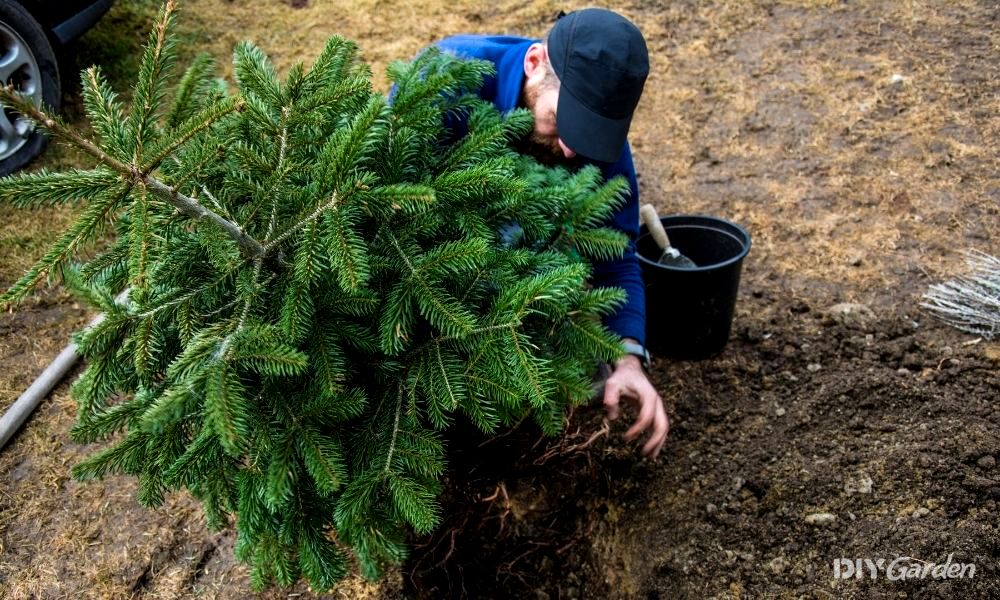
Having a real Christmas tree at home during the festive season has a certain appeal. They provide a forest feel and a piney smell like no candle can imitate!
If you’re wondering what to do with your living tree after Christmas, planting it in the garden is a great idea. You can enjoy it all year round (possibly forever!) and can even dig it up to use again next year.
Here’s everything you need to know about how to plant a living Christmas tree in your garden after the festive season.
How Do You Know If You Can Replant a Christmas Tree?
There are two key things you need to figure out to determine whether you can replant your Christmas tree in the garden (and whether it’ll survive!).
1. The Roots Are Still In-Tact
Peek inside your pot and see whether the roots (also called a root ball) are still living on your Christmas tree. Sometimes, they are cut off before the tree is sold, so only the stump remains. But if you have roots, you’re good to plant!
2. It’s Pot-Grown
Depending on how your tree was grown, it’ll have a different chance of surviving being replanted in the garden. There are two ways Christmas trees can be grown:
- In the ground – Trees that were grown in the ground before being transferred to a pot will have some root damage. They may survive being planted outside, but they may not. It’s 50/50!
- In a pot or container – These trees were planted in a pot and have stayed in a pot all their life. Container-grown trees are much more likely to survive when planted in your garden.
You can still plant a Christmas tree that was originally dug up from the ground. However, pot-grown trees will have a better chance of surviving long-term. Check with the supplier before you buy if you’re planning on planting the Christmas tree in your garden after use.
What Soil Do Christmas Trees Like?
Christmas trees are not very picky when it comes to soil. They can thrive in most soil types as long as it’s well-drained. The only soil they don’t like is highly acidic or clay-heavy types.
Loam soil (which is a mixture of clay, sand and silt) is best for keeping soil well-drained. Plus, it’ll help your Christmas tree maintain a green appearance.
How to Plant a Christmas Tree in the Garden
There are three main steps involved in planting a Christmas tree in the garden.
1. Prepare
For your Christmas tree to survive outside, it needs to be prepared for the shift in temperature.
Before you plant your tree in the ground, place it outside (still in the pot) for 1-2 weeks. Keep it undercover if you can and water it regularly. This will help your tree adjust to the climate and will boost its survival rate.
Trees that you plan on replanting outside should only be kept indoors for around a week. Any longer and they may not survive the change.
2. Dig
Once your Christmas tree has adjusted to the temperature change, it’s time to dig a hole where you want it. If you can, dig the hole before winter sets in, around autumn time. The soil will be much softer and easier to dig.
Dig a hole that is at least three times as wide as the root ball and deep enough for it to comfortably fit in. If the soil around the hole you’ve dug is very compacted, loosen it up with a pitchfork.
3. Plant
Place the tree in the hole and make sure it’s standing upright (and not wonky). Carefully fill in the sides with soil and pat it down firmly. This will help remove pockets of air and help the tree stay upright.
Once it’s packed in, water your Christmas tree deeply. To help it adjust quicker, add mulch to the top layer of soil around the base of the tree.
Conclusion
Replanting your old Christmas tree is a great way to recycle it. Plus, it’ll invite the local wildlife to enjoy your garden. But if your Christmas tree isn’t re-plantable, there’s no need to throw it out yet!
When removed, the pine needles make excellent mulch. For the rest of the tree, use a chipper to shred it. If you scatter the remains under your shrubs, you’ll add a healthy dose of nutrients to the soil.
